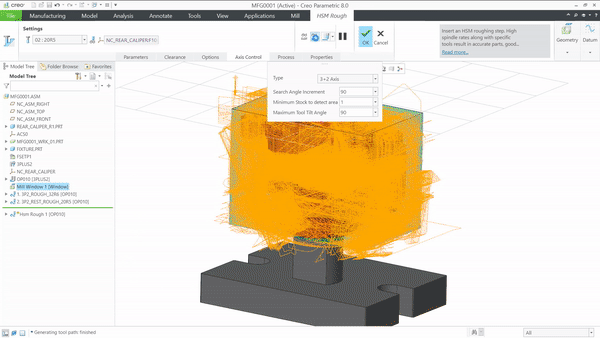
Creo 8’s MBD and detailing tools help create rich CAD models that can be the source authority for manufacturing and inspection. Image Courtesy of PTC.
Latest News
April 26, 2021
The latest release of PTC’s Creo hits a variety of notes, including improvements to simulation, generative design, and model-based definition capabilities, the overall theme being to improve productivity for everyday users as they continue to digitally transform design and engineering processes.
Creo 8 delivers an array of new functions with major investments in emerging technologies like simulation-driven design, additive manufacturing, and generative design. “We continue to invest in emerging technologies and also provide enhancements to make design engineers more efficient and productive on a day-to-day basis,” says Paul Sagar, PTC’s vice president CAD product data management.
One of the more prominent areas of focus are general usability and productivity enhancements. Creo 8 streamlines workflows with improved dashboards and model tree interfaces along with enhancements to popular features, including holes, routed systems, sheet metal, and Render Studio. For example, there is an ability to create multiple holes in a single hole feature to speed up the design process along with something called inseparable assemblies—a capability that embeds the assembly structure and parts into the assembly itself, making for easier management of purchased components from suppliers. “Under the hood, the assembly structure still exists, but from a pure data management perspective, you manage it as a single business object,” Sagar explains.
Promoting model-based engineering (MBE) design practices is another focal point of the Creo 8 release, intended to help customers transform from 2D practices into 3D-centric practices that can fully capitalize on the benefits of the digital thread. The latest release lets users apply geometric dimensioning and tolerancing for assemblies using the updated GD&T Advisor Plus extension. There are also robust detailing capabilities thanks to new sketching tools, allowing an extended chain of users to more easily convey design intent, Sagar says.
With Creo 8, PTC continues its emphasis on generative design and simulation. The new release makes it easier to set up generative design problems and allows users to continue to do other work inside of Creo while the software is calculating the optimal design based on input parameters. On the simulation front, PTC and Ansys continue to expand their partnership to make it easier to do simulation within CAD—in this release, with steady-state flow analysis for real-time simulation as well as improved mesh and deflection control for high-fidelity design validation.

The fourth bucket of enhancements fall in the AM and subtractive manufacturing, including support for new simulation-driven lattice structures for lightweighting initiatives and enhancements that make it easier to specify build direction and tray setup. Both feature sets are designed to help users increase production speed and elevate quality. Subtractive manufacturing got a boost via Creo 8’s features that simplify the programming of five-axis, high-speed milling toolpaths, resulting in reduced set up and machining time.
For more on what’s in Creo 8, check out this video.
More PTC Coverage
Subscribe to our FREE magazine, FREE email newsletters or both!
Latest News
About the Author
Beth Stackpole is a contributing editor to Digital Engineering. Send e-mail about this article to [email protected].
Follow DE






